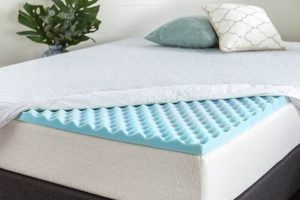Addressing the heat retention often associated with viscoelastic foam bedding is a common concern. These mattresses, known for their conforming comfort, can sometimes trap body heat, leading to discomfort during sleep. The objective is to mitigate this heat buildup and create a cooler, more restful sleeping environment. For example, selecting breathable bedding materials contributes significantly to temperature regulation on such surfaces.
Maintaining a comfortable sleep temperature is crucial for achieving restful and restorative sleep. Excess heat can disrupt sleep cycles, leading to restlessness and reduced sleep quality. Historically, individuals have sought various methods to improve sleep temperature, ranging from natural ventilation to specialized bedding solutions. The benefits of temperature-regulated sleep include improved sleep onset, deeper sleep stages, and enhanced overall well-being.
The following sections will explore practical strategies and solutions to effectively manage temperature on memory foam mattresses. These methods encompass material selection, ventilation techniques, and supplementary cooling devices, offering a range of options for achieving a more comfortable sleep experience.
Strategies for Reducing Heat Retention in Memory Foam Mattresses
Effective heat management in memory foam mattresses requires a multi-faceted approach. The following strategies address common causes of heat buildup and offer practical solutions for improved sleep comfort.
Tip 1: Opt for Breathable Bedding: Natural fibers like cotton, linen, and bamboo facilitate air circulation and moisture wicking, minimizing heat accumulation on the mattress surface.
Tip 2: Utilize a Mattress Topper Designed for Cooling: Toppers constructed with gel-infused memory foam or breathable materials such as latex can dissipate heat and enhance airflow.
Tip 3: Employ a Bed Frame that Promotes Airflow: Slatted bed frames or those with open designs allow for greater ventilation underneath the mattress, preventing heat from being trapped.
Tip 4: Regulate Room Temperature: Maintaining a cool ambient temperature within the bedroom, ideally between 60-67 degrees Fahrenheit (15-19 degrees Celsius), can significantly impact sleep comfort.
Tip 5: Consider Cooling Pillows: Pillows incorporating cooling gels, breathable fabrics, or shredded memory foam can reduce heat buildup around the head and neck.
Tip 6: Wash Bedding Frequently: Regular washing removes accumulated body oils and sweat, which can impede airflow and contribute to heat retention.
Tip 7: Explore Active Cooling Systems: Mattress pads with integrated cooling technology circulate cool air or water through the mattress, providing precise temperature control.
Implementing these strategies can substantially improve the thermal comfort of a memory foam mattress, promoting restful and undisturbed sleep.
The subsequent section will provide an overview of product selection considerations relevant to temperature management in memory foam mattresses.
1. Breathable Materials
The selection of breathable materials is a critical factor in mitigating heat retention associated with viscoelastic foam bedding. The inherent density of this material often restricts airflow, leading to the accumulation of body heat and potential sleep discomfort. Employing breathable textiles in sheets, mattress protectors, and even the mattress cover itself, provides a pathway for heat dissipation, promoting a more comfortable sleep environment.
- Fiber Structure and Air Permeability
The physical structure of different fibers significantly influences their breathability. Natural fibers such as cotton, linen, and bamboo possess inherent microscopic channels that facilitate air circulation and moisture wicking. In contrast, synthetic materials like polyester, particularly those with a tight weave, tend to impede airflow. The air permeability rating of a fabric indicates its ability to allow air to pass through; higher ratings correlate with greater breathability and cooling potential.
- Moisture Management Properties
Breathable materials excel at wicking away moisture, primarily perspiration, from the skin. Moisture accumulation can increase the sensation of warmth and stickiness, disrupting sleep. Fibers with effective moisture management properties transport moisture away from the body, allowing it to evaporate more readily. This process reduces humidity within the sleep microclimate, contributing to a cooler and drier sleeping environment.
- Weave and Construction Techniques
The weave and construction methods employed in textile manufacturing significantly impact breathability. Loose weaves, such as percale or jersey, allow for greater airflow compared to tighter weaves like sateen. Additionally, knitted fabrics tend to be more breathable than woven fabrics due to their inherent flexibility and porous structure. Open-weave constructions maximize ventilation, enhancing the cooling effect of the material.
- Material Weight and Thickness
Lighter-weight and thinner materials generally exhibit greater breathability than heavier and thicker fabrics. Thicker materials can create a barrier to airflow, trapping heat and moisture. Selecting bedding with a lower fabric weight can improve ventilation and reduce heat retention. The impact of material weight is particularly relevant for mattress protectors and covers, where a thinner, breathable option is preferable for minimizing thermal buildup.
The characteristics of breathable materials, encompassing fiber structure, moisture management, weave, and weight, collectively determine their effectiveness in counteracting heat retention in memory foam mattresses. Selecting bedding constructed from these materials is a direct and impactful strategy for promoting a cooler and more comfortable sleep experience.
2. Ventilation Improvement
Improved ventilation directly addresses heat accumulation, a primary concern associated with viscoelastic foam bedding. The inherent density of memory foam restricts natural airflow, leading to the trapping of body heat and the potential for elevated sleep surface temperatures. Enhancing ventilation promotes heat dissipation, thereby contributing significantly to a cooler and more comfortable sleep environment. Failure to address ventilation deficiencies can negate the effectiveness of other cooling strategies.
Strategies for ventilation improvement include the selection of bed frames designed for optimal airflow. Slatted bed frames, for example, allow air to circulate freely beneath the mattress, preventing heat from being trapped. Conversely, solid platfor
m beds can impede airflow, exacerbating heat retention. Similarly, the use of breathable mattress protectors and toppers contributes to ventilation by facilitating air movement through the bedding layers. Real-world examples demonstrate that replacing a solid platform bed with a slatted frame often results in a noticeable reduction in sleep surface temperature.
The practical significance of understanding the relationship between ventilation improvement and temperature regulation in memory foam mattresses lies in its impact on sleep quality. By implementing strategies to enhance airflow, individuals can mitigate heat buildup and create a more conducive sleep environment. The challenge lies in selecting appropriate bed frames and bedding materials that promote ventilation without compromising support or comfort. Addressing this challenge is crucial for maximizing the benefits of memory foam mattresses and achieving restful sleep.
3. Temperature Regulation
The ability to regulate temperature is a critical component in mitigating heat retention within viscoelastic foam bedding. Temperature regulation refers to the active or passive processes that maintain a stable and comfortable thermal environment. The inherent properties of memory foam, known for conforming to body contours, can also impede airflow, leading to heat accumulation. Consequently, effective temperature regulation strategies are essential to counteract this effect and promote restful sleep. In the context of managing the thermal properties of memory foam mattresses, temperature regulation encompasses a range of interventions aimed at dissipating heat and maintaining a comfortable sleep surface temperature.
Several approaches facilitate temperature regulation in this context. These include utilizing breathable bedding materials, such as cotton, linen, or bamboo, which allow for greater airflow compared to synthetic alternatives. Mattress toppers designed with cooling gels or phase-change materials actively absorb and dissipate heat. Bed frames designed to promote airflow, such as slatted frames, further enhance ventilation and prevent heat buildup. Active cooling systems, such as mattress pads with integrated fans or water circulation, offer a more controlled means of temperature regulation. For instance, studies have demonstrated that individuals using cooling mattress pads experience a significant reduction in core body temperature during sleep, leading to improved sleep quality. The selection and implementation of these strategies hinge on the individual’s specific needs and preferences, as well as the ambient environmental conditions.
In summary, temperature regulation represents a crucial element in achieving optimal sleep comfort with viscoelastic foam mattresses. By employing strategies that enhance heat dissipation and maintain a stable sleep surface temperature, individuals can mitigate the heat retention often associated with this material. The challenge lies in identifying and implementing the most effective combination of techniques based on individual requirements and environmental factors, ultimately leading to a more restful and restorative sleep experience. Addressing temperature regulation effectively transforms the potential drawback of heat retention into a manageable aspect of memory foam mattress ownership.
4. Cooling Toppers
The efficacy of a viscoelastic foam mattress is often predicated on its ability to conform to the body’s contours, thereby providing enhanced pressure relief. However, the inherent density of memory foam frequently impedes airflow, resulting in heat retention. Cooling toppers represent a targeted intervention designed to mitigate this adverse thermal characteristic. These toppers introduce a supplementary layer engineered to dissipate heat and promote a more comfortable sleep surface, acting as a primary component in strategies for thermal regulation.
Cooling toppers typically incorporate materials with enhanced thermal conductivity, such as gel-infused memory foam, latex, or phase-change materials. Gel infusions increase heat dissipation, while latex offers inherent breathability. Phase-change materials absorb and release heat to maintain a consistent temperature. For example, individuals who experience night sweats often find significant relief by using a gel-infused memory foam topper, which draws heat away from the body, resulting in a more restful sleep. Without a cooling topper, heat accumulates at the point of contact, disrupting sleep cycles and potentially leading to discomfort.
In essence, cooling toppers serve as a direct solution to a common problem associated with memory foam mattresses. While not a singular solution, their contribution to overall thermal management is significant. The challenge lies in selecting a topper that complements the existing mattress and meets individual thermal needs. The understanding of this connection underscores the importance of proactive measures for ensuring a comfortable sleep environment on viscoelastic foam bedding.
5. Active Cooling
Active cooling technologies represent a direct intervention strategy for managing heat retention within viscoelastic foam mattresses. The inherent thermal properties of memory foam often lead to the accumulation of body heat, disrupting sleep quality. Active cooling systems counteract this by actively removing heat from the sleep surface, providing a demonstrable cooling effect. This directly addresses the problem of overheating experienced by some users of these mattresses, thus actively contributing to its resolution. These systems distinguish themselves from passive methods, such as breathable materials, by employing external energy to drive the cooling process.
Several active cooling methods are currently available, including mattress pads with integrated fans that circulate air and water-cooled systems that utilize a network of tubing to dissipate heat. For instance, a water-cooled mattress pad circulates chilled water through a thin layer on top of the mattress, effectively reducing the surface temperature. Air-based systems draw heat away from the body using low-power fans embedded within the pad. The selection of an appropriate active cooling system depends on individual preferences and needs; some prefer the consistent cooling of water-based systems, while others prioritize the airflow provided by fan-based solutions. In practical application, active cooling systems demonstrably lower the temperature of the sleep surface, facilitating easier sleep onset and reducing nighttime disturbances caused by overheating. These systems also allow users to fine-tune the cooling intensity based on ambient temperature and personal comfort levels.
In summary, active cooling mechanisms provide a targeted approach to counteract the heat-retentive properties of memory foam mattresses. The ability to actively regulate temperature is a significant advantage for individuals seeking a cooler sleep environment. While the initial investment in an active cooling system may be higher compared to passive methods, the enhanced temperature control and subsequent improvements in sleep quality often justify the cost. The challenges associated with active cooling relate to the potential for noise generated by fans or pumps and the n
eed for regular maintenance of the cooling system. Despite these challenges, active cooling remains a valuable component in optimizing the sleep experience on memory foam mattresses.
6. Humidity Control
Elevated humidity levels significantly exacerbate the perception of heat associated with viscoelastic foam mattresses. The moisture content in the air impedes the evaporation of perspiration, thereby hindering the body’s natural cooling mechanisms. This heightened humidity effectively traps heat within the sleep environment, negating the benefits of other cooling strategies. Controlling humidity, therefore, forms a crucial component in managing the thermal properties of memory foam mattresses. A dehumidified environment promotes efficient evaporative cooling, leading to a lower perceived temperature and enhanced sleep comfort. For example, individuals residing in humid climates often report heightened thermal discomfort when using memory foam mattresses, underscoring the impact of humidity. Effective humidity control, such as the use of a dehumidifier, complements other cooling measures, creating a more conducive sleep environment.
Practical applications of humidity control include implementing dehumidifiers within the bedroom, particularly during periods of high humidity. Additionally, selecting bedding materials with moisture-wicking properties further aids in maintaining a dry sleep surface. Regularly laundering bedding also removes accumulated moisture and body oils that can contribute to humidity within the mattress microclimate. Furthermore, ensuring adequate ventilation within the bedroom helps to dissipate moisture and prevent the buildup of humidity. A real-world example could be a test comparing sleep quality with and without a dehumidifier in a humid room, with quantifiable data on sleep latency, sleep duration, and reported thermal comfort. The understanding of these connections allows for a targeted approach to managing the thermal properties of memory foam mattresses, resulting in improved sleep quality.
In summary, humidity control is not merely an ancillary factor but an integral component in effectively managing the thermal characteristics of memory foam mattresses. Elevated humidity impedes evaporative cooling, increasing the perceived temperature and negating other cooling efforts. Employing dehumidifiers, selecting moisture-wicking bedding, and ensuring adequate ventilation are all effective strategies for controlling humidity within the sleep environment. The challenge lies in balancing humidity control with other factors such as temperature and ventilation to create an optimal sleep environment. Effectively addressing humidity represents a critical step in maximizing the comfort and sleep benefits of viscoelastic foam bedding.
Frequently Asked Questions
The following addresses common inquiries regarding the thermal properties of viscoelastic foam mattresses and strategies for mitigating heat retention.
Question 1: Does all memory foam retain heat equally?
No, variations exist. Open-cell memory foam and gel-infused memory foam are designed to improve airflow and dissipate heat more effectively than traditional, denser formulations. The manufacturing process and material composition significantly influence the thermal characteristics.
Question 2: Will a mattress protector negate efforts to cool a memory foam mattress?
The material composition of the protector is paramount. Non-breathable materials, such as vinyl, will impede airflow and exacerbate heat retention. Opt for protectors made from breathable fabrics like cotton, bamboo, or Tencel to maintain ventilation.
Question 3: Is there a correlation between mattress thickness and heat retention?
Generally, thicker mattresses tend to retain more heat due to the increased volume of insulating material. However, mattress construction, including the presence of cooling layers, can mitigate this effect.
Question 4: Can bedroom humidity levels impact the effectiveness of cooling strategies?
Yes, elevated humidity hinders evaporative cooling, rendering cooling strategies less effective. Utilizing a dehumidifier can reduce humidity levels and enhance the performance of cooling methods.
Question 5: Do cooling mattress pads require significant energy consumption?
Energy consumption varies depending on the model and cooling technology. Many modern cooling mattress pads are designed for energy efficiency and consume minimal electricity. Consider energy consumption ratings when selecting a cooling pad.
Question 6: Is there a difference between “cooling” and “temperature regulating” mattress toppers?
“Cooling” toppers typically utilize materials with enhanced thermal conductivity to dissipate heat. “Temperature regulating” toppers often incorporate phase-change materials that actively absorb and release heat to maintain a consistent temperature. The optimal choice depends on individual preferences and the desired level of temperature control.
Addressing the thermal characteristics of memory foam mattresses requires a multifaceted approach, considering material selection, ventilation, and environmental factors. The selection of appropriate strategies is contingent upon individual needs and preferences.
The subsequent section will explore specific product recommendations relevant to heat management in viscoelastic foam bedding.
Effective Mitigation of Heat Retention in Viscoelastic Foam Mattresses
The preceding discussion has comprehensively explored strategies on how to cool down my memory foam mattress, encompassing material selection, ventilation enhancement, temperature regulation technologies, and humidity management. These factors collectively influence the sleep surface temperature and contribute to overall sleep comfort. Successfully addressing these elements is crucial for maximizing the benefits of memory foam while minimizing the potential for heat-related discomfort.
Ultimately, optimizing the thermal environment of a memory foam mattress necessitates a tailored approach, considering individual preferences, environmental conditions, and the specific characteristics of the mattress itself. Continued advancements in material science and cooling technologies offer ongoing opportunities to enhance the sleep experience. The proactive implementation of informed strategies will contribute to improved sleep quality and overall well-being.


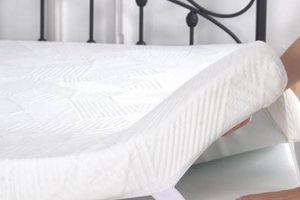
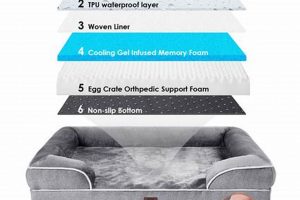
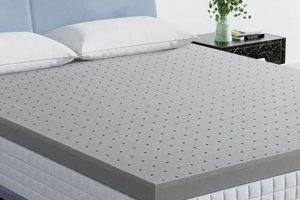
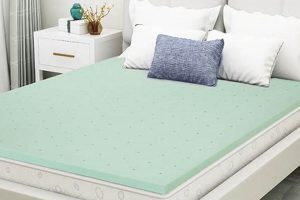
![Top Rated Best Memory Foam Mattress Brands [Year] Organic & Natural Mattress Buyer’s Guide: Non-Toxic Sleep Solutions Top Rated Best Memory Foam Mattress Brands [Year] | Organic & Natural Mattress Buyer’s Guide: Non-Toxic Sleep Solutions](https://mattressworldpa.com/wp-content/uploads/2025/07/th-4022-300x200.jpg)
